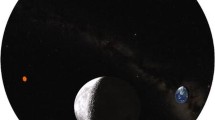Abstract
We present a novel approach to teaching astronomy and planetary sciences, centered on visual images and simulations of planetary objects. The basic idea of the “Thinking Journey” concept is to take the students to other celestial objects as tourists, and to teach science through the observatio of various natural phenomena in these new environments. The power of scientific visualization, through still and dynamic images, makes such a journey an exciting learning experience. The introduction of new technologies (3D animations, virtual reality) greatly enhances the visualization capabilities the teacher can use, allowing him to simulate actual flights over the terrain of other planets and to study them as if observing from a spaceship in orbit. The present program focuses on the study of the Moon and of the planet Mars, by means of observation, interpretation, and comparison to planet Earth. Students learn to recognize geological and atmospheric processes, discuss astronomic phenomena, and discover that the same basic physical laws govern all objects in the solar system.
Similar content being viewed by others

REFERENCES
Barab, S. A., Hay, K. E., Squire, K., Barnett, M., Schmidt, R., Karrigan, K., Yamagata-Lynch, L., and Johnson, C. (2001). Virtual solar system project: Learning through a technology-rich, inquiry-based, participatory learning environment. Journal of Science Education and Technology 9: 7–25.
Bennet, J. O. (1999). Strategies for teaching astronomy. Mercury 28: 24–31.
Bliss, J., and Ogborn, J. (1989). Tools for exploratory learning. Journal of Computer Assisted Learning 5: 37–50.
Comins, N. F. (1993). Misconceptions about astronomy: Their origins. In Novak, J. D. (ed.), Proceedings of the 3rd International Seminar on Misconceptions in Science and Mathematics, Cornell University, Cornell.
DeLaughter, J. E., Stein, S., Stein C. A., and Bain, K. R. (1998). Preconceptions abound among students in an introductory earth science course. EOS 79: 429–431.
Feuerstein, R. (1998). The Human Being as a Changing Entity, Tel-Aviv Broadcasted University. (In Hebrew)
Feuerstein, R., Rand, Y., and Rynders, J. E. (1988). Don't Accept Me as I Am—Helping “Retarded” People to Excel, Plenum, New York.
Gazit, E., and Chen, D. (2000). “A Virtual Journey through the solar system”: Learning basic astronomical phenomena by using virtual reality technology. A case study (preliminary results). In Proceedings of the 12th Scientific Conference of the Israeli Association for Research on Education, Tel-Aviv, Israel, pp. 303–308. (In Hebrew)
Gilbert, J. K., and Reiner, M. (2000). Thought experiments in science education: Potential and current realization. International Journal of Science Education 22: 265–283.
Goforth, D. (1994). Learner control = decision making + information: A model and meta-analysis. Journal of Educational Computing Research 11: 1–26.
Harper, B., Squires, D., and McDougall, A. (2000). Constructivist simulations: A new design paradigm. Journal of Educational Multimedia and Hypermedia 9: 115–130.
Lanciano, N. (1999). Teaching and learning astronomy at the elementary school level. In Gouguenheim, L., McNally, D., and Percy J. R. (Eds.), New Trends in Astronomy Teaching, Cambridge University Press, Cambridge, pp. 133–138.
Miller, R., and Hartman, W. K. (1993). The Grand Tour—A Traveler's Guide to the Solar System, Workman Publishing, New York, 208 pp.
Mohler, J. L. (2000). Desktop virtual reality for the enhancement of visualization skills. Journal of Educational Multimedia and Hypermedia 9: 151–165.
Nussbaum, J. (1985). The Earth as a cosmic body. In Driver, R., Guesne, E., and Tiberghien, A. (Eds.), Children's Ideas in Science, Open University Press, Milton Keynes, Chap. 9
Perrig, W., and Kintsch, W. (1985). Prepositional and situational representations of text. Journal of Memory and Language 24: 503–518.
Scardamalia, M., Bereuter, C., McLean, R., Swallow, J., and Woodruff, E. (1989). Computer supported intentional learning environments. Journal of Educational Computing Research 5: 51–68.
Schur, Y. (1998). A Thinking Journey to the Moon, Ma'alot Press, Jerusalem, 216 pp. (In Hebrew)
Schur, Y., Brandt, R., and Yair, Y. (2002). A Thinking Journey to Mars, Center for Educational Technology, Tel Aviv, 155 pp.
Shapiro, C., Whitney, P., Sadler, M., and Schneps, I. (1988). A private Universe [Videotape], Harvard-Smithsonian Center for Astrophysics, Science Education Department, Science Media Group.
Yair, Y., Mintz, R., and Litvak, S. (1997). Touch the Sky, Touch the Universe. A Multimedia-Based Astronomy Encyclopedia [CD-ROM], Center for Educational Technology, TelAviv.
Yair, Y., Mintz, R., and Litvak, S. (2001). 3D-virtual reality in science education: An implication for astronomy teaching. Journal of Educational Multimedia and Hypermedia 20: 293–305.
Author information
Authors and Affiliations
Corresponding author
Rights and permissions
About this article
Cite this article
Yair, Y., Schur, Y. & Mintz, R. A “Thinking Journey” to the Planets Using Scientific Visualization Technologies: Implications to Astronomy Education. Journal of Science Education and Technology 12, 43–49 (2003). https://doi.org/10.1023/A:1022107627775
Issue Date:
DOI: https://doi.org/10.1023/A:1022107627775



